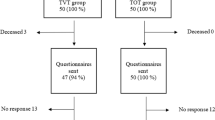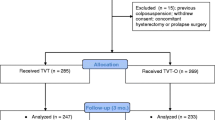Abstract
The goals of this study were to assess the efficacy of inside-out transobturator vaginal tape (TVT-O) as a treatment of urodynamic stress incontinence (USI) and to explore the possible factors determining surgical success and failure. Each woman had a 20-min pad test and urodynamic study including uroflowmetry, cystometry, and stress urethral pressure profile before and after treatment. Forty-six of the 54 women (85%) were cured of the disease, and two (4%) showed clinical improvement; TVT-O had failed to treat USI in six patients (11%) during the 9-month follow-up period. We assessed the relationship between clinical features, urodynamic parameters, and treatment outcome. Of these, only age and previous anti-incontinence surgery were significant risk factors for surgical failure. The success rate during the 9-month follow-up period decreased significantly in women ≧60 years and in women with previous anti-incontinence surgery. Women with USI can be treated by the TVT-O procedure.


Similar content being viewed by others
Abbreviations
- TVT:
-
tension-free vaginal tape
- TVT-O:
-
inside-out transobturator vaginal tape
- USI:
-
urodynamic stress incontinence
- SUI:
-
stress urinary incontinence
- ICS:
-
International Continence Society
References
Ulmsten U, Henriksson L, Johnson P, Varhos G (1996) An ambulatory surgical procedure under local anesthesia for treatment of female urinary incontinence. Int Urogynecol J 7:81–86
DeLancey JO (1994) Structural support of the urethra as it relates to stress urinary incontinence: the hammock hypothesis. Am J Obstet Gynecol 170:1713–1720
Costa P (2000) Mecanismes de Ia continence a I’effort chez Ia femme. Actualites en Urodynamique-Societe Internationale Francophone d’Urodynamique. Elsevier, Paris
Petros P, Ulmsten U (1993) An integral theory and its method for the diagnosis and management of female urinary incontinence. Scand J Urol Nephrol Suppl 153:1–93
Ulmsten U (2001) The basic understanding and clinical results of tension-free vaginal tape for stress urinary incontinence. Urology 40:269–273
de Leval J (2003) Novel surgical technique for the treatment of female stress urinary incontinence: transobturator vaginal tape inside-out. Eur Urol 44:724–730
Daher N, Boulanger JC, Ulmsten U (2003) Pre-pubic TVT: an alternative to classic TVT in selected patients with urinary stress incontinenc. Eur J Obstet Gynecol Reprod Biol 107:205–207
Delorme E (2001) Transobturator urethral suspension: mini-invasive procedure in the treatment of stress urinary incontinence in women. Prog Urol 11:1306–1313
Delmas V, Hermieu JF, Dompeyre P, Messas A, Dumonceau O, Ravery V et al (2003) The uratape transobturator sling in the treatment of female stress urinary incontinence: mechanism of action. Eur Urol Suppl 2(1):196, [Abstract 776]
Droupy S, De Tayrac R, Delorme E (2003) Transobturator urethral support for female stress urinary incontinence: 1 year outcome of a new surgical procedure. Eur Urol 2(1):197 (Suppl), [Abstract 779]
Hermieu JF, Messas A, Delmas V, Ravery V, Dumonceau O, Boccon-Gibod L (2003) Plaie vesicale après bandelette trans-obturatrice. Prog Urol 13:115–117
Delmas V (2004) Novel surgical technique for the treatment of female stress urinary incontinence: transobturator vaginal tape inside-out (letter to the editor). Eur Urol 46:134
Sand PK, Ostergard DR (1995) Pad testing. In: Sand PK, Ostergard DR (eds) Urodynamics and the evaluation of female incontinence: a practical guide. Springer, Berlin Heidelberg New York, pp 20–23
Abrams P, Cardozo L, Fall M, Griffiths D, Rosier P, Ulmsten U et al (2003) The standardisation of terminology in lower urinary tract function: report from the standardisation sub-committee of the International Continence Society. Urology 61:37–49
Waltregny D, Reul O, Bonnet P, de Level J (2004) Inside-out transobturator vaginal tape (TVT-O): short-term results of a prospective study. Neurourol Urodyn 23:428–429
Cetinel B, Demirkesen O, Onal B, Akkus E, Alan C, Can G (2004) Are there any factors predicting the cure and complication rates of tension-free vaginal tape? Int Urogynecol J 15:188–193
Amaye-Obu FA, Drutz HP (1999) Surgical management of recurrent stress urinary incontinence: a 12-year experience. Am J Obstet Gynecol 181:1296–1309
Rardin CR, Kohli N, Rosenblatt PL, Miklos JR, Moore R, Strohsnitter WC (2002) Tension-free vaginal tape: outcomes among women with primary versus recurrent stress urinary incontinence. Obstet Gynecol 100:893–89 7
Author information
Authors and Affiliations
Corresponding author
Rights and permissions
About this article
Cite this article
Chen, HY., Yeh, LS., Chang, WC. et al. Analysis of risk factors associated with surgical failure of inside-out transobturator vaginal tape for treating urodynamic stress incontinence. Int Urogynecol J 18, 443–447 (2007). https://doi.org/10.1007/s00192-006-0172-0
Received:
Accepted:
Published:
Issue Date:
DOI: https://doi.org/10.1007/s00192-006-0172-0




